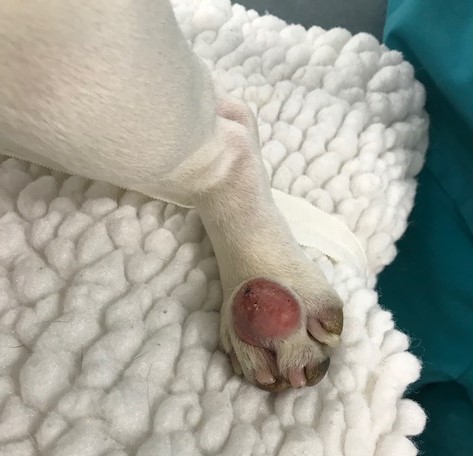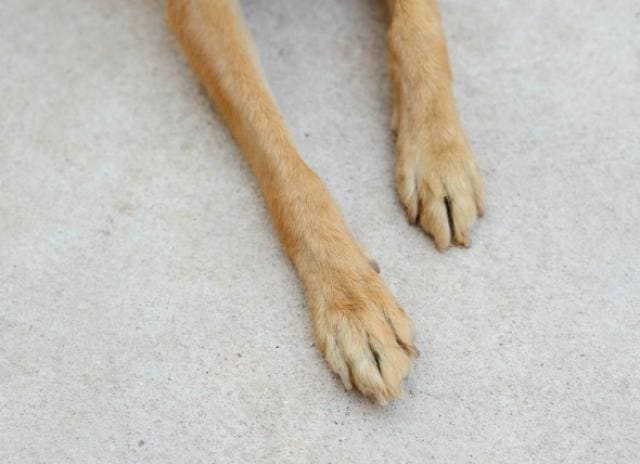
The mast cell tumor is the most frequently diagnosed malignant skin cancer in dogs. Mast cell tumors of the nail bed in the dog are usually aggressive and these dogs face poorer prognosis.

They are normally found in the body and are most often found on your dogs skin either on the surface or underneath.
Mast cell tumor dog tow. What is a mast cell tumor in dogs. Mast cell tumors are a common type of dog skin cancer. This invasive tumor is made up of mast cells which are a type of cell that is involved in the allergic response.
Most dog mast cell tumors appear as a lump on the skin but this cancer can also affect the bone marrow spleen or liver. What is a mast cell tumor. A mast cell tumor MCT is a type of tumor consisting of mast cells.
Mast cell tumors most commonly form nodules or masses in the skin they can also affect other areas of the body including the spleen liver intestine and bone marrow. Mast cell tumors MCT are the most common skin. Most dogs with MCT 60-70 only develop one tumor.
Mast cell tumors are a common cancer in dogs and cats. Most are located on the skin or in the tissue layer below the skin called the subcutaneous tissue. Mast cell tumors are considered a Great Mimicker and can have a wide range of appearances.
Any lump or bump you find on your dog that persists for over a week should be examined by a vet. What Are Mast Cell Tumors In Dogs. Mast cell tumors in dogs are a type of tumor that affects mast cells a type of white blood cell the body uses for allergy response.
With these tumors the mast cells start releasing a high amount of chemicals into the body. Mast Cell tumors are the most common skin tumor in dogs making up around 20 of all diagnosed cases. Mast Cell Tumors Mast Cell Tumors Mast cell tumor MCT also called mastocytoma is a common skin tumor in dogs.
The mast cell tumor is the most frequently diagnosed malignant skin cancer in dogs. Dogs are diagnosed at an average of 8 years old although puppies as young as 4 months may be affected. A 2-tiered histologic grading scheme for canine cutaneous mast cell tumors MCTs is based on morphologic characteristics of neoplastic cells including karyomegaly multinucleation nuclear pleomorphism and mitotic figures.
Aspirates from MCTs may provide the same information more quickly inexpen. What is a mast cell tumour. Mast cell tumours occur from the abnormal proliferation of mast cells which are allergy cells that lead to itchiness and swelling.
It is one of the most common skin cancers in dogs. This cancer can occur in dogs of any age. However certain breeds are more prone to developing mast cell tumours.
What do mast cell tumours look like. What is a Mast Cell Tumor. Mast Cell Tumors MCTs are one of the most common malignant skin tumors in dogs.
Mast cells are the cells that normally are associated with allergy responses such as the swelling and redness that occur with insect stings. In dogs mast cell tumors typically are located in the skin of the trunk and peripheral limbs. He is the sweetest dog - and gorgeous too.
He is 105yrs old and in August was diagnosed with a small malignant mast cell tumor. We were told that due to its location in his shoulder it was not operable. He had significant bleeding when the.
STEL FONTA tigilanol tiglate injection Mast Cell Tumor Treatment. Approved by the FDA as a mast cell tumor treatment in dogs. Non-metastatic cutaneous mast cell tumors and non-metastatic subcutaneous mast cell tumors located at or distal to the elbow or the hock in dogs.
Watch Mode of Action. Mast Cell Tumours in Dogs. A mast cell tumour MCT is the most common malignant skin tumour in dogs.
In fact it is estimated that up to 20 of skin masses in dogs are actually MCTs. They are normally found in the body and are most often found on your dogs skin either on the surface or underneath. As they are involved in allergic and inflammatory.
Response of Canine Mast Cell Tumors to Treatment With Oral Prednisone Dudley L. Brewer Jr Mary Kay Klein Ford W. Bell and Sharon K.
Anderson Twenty-five dogs with naturally occurring mast cell tumors were treated with daily oral prednisone 1 mgkg for 28 days. Mast Cell Tumors in Dogs and Cats - Veterinary Partner - VIN. Most mast cell tumors arise in the skin but technically they can arise anywhere that mast cells are found.
Mast cell tumors are notoriously invasive and difficult to treat. My dogs tumor is in an inoperable location in the muscle near his spine so this is one of few options for him. He is 17 years old.
Yes I have had success with MAST cell. Three days ago I saw one of my mast cell cases that had a large mast cell on is flank that was surgically removed with the oncology group. This was over.
The medical professional will take a needle gently poke through your dogs skin and pull a small sample of the mast cell tumor out of your dog. The needle draws the sample of cancerous cells out and into a syringe which they then take to the lab for clinical testing. What are Mast Cell Tumours.
Mast cell tumours are malignant and aggressive cancers of cells called mast cells Mast cells are found in the dermis and subcutaneous tissues of the skin of dogs and cats. Mast cell tumours are the most common malignant skin tumour of dogs and the second most common malignant skin tumour of cats. Mast cell tumours in dogs arise from a special type of cell that typically lives in the skin.
Their job is to orchestrate inflammatory reactions. Therefore mast cell tumours in dogs can show changes typically associated with inflammation like swelling and redness. In fact owners often comment that the lump in question has been fluctuating in.
Recently interstitial brachytherapy with iridium-192 has been evaluated as an adjuvant treatment for cutaneous mast cell tumors in dogs31 In this study nine dogs with microscopic residual disease and two dogs with macroscopic disease were treated with interstitial brachytherapy. Virbac a global animal health company that has launched the Stelfonta product has stated the following. 75 of mast cell tumors achieved resolution of the target tumor with just one treatment.
88 of dogs achieve the target tumours resolution 28 days after either the first or 28 days after a second treatment. 12 weeks after a single injection 96 of dogs remained. Mast cell tumors of the nail bed in the dog are usually aggressive and these dogs face poorer prognosis.
The prognosis for cats with metastatic nail bed tumors is very poor with a median survival time of approximately 15 months. Amputation of the affected area rarely helps because the tumor typically spreads to other areas very quickly. The medical records of 24 dogs with histologically confirmed mast cell tumors MCT of the muzzle were retrospectively evaluated to determine their biologic behavior and prognostic factors.
Information on signalment tumor grade and stage treatment methods and pattern of and time to failure and death was obtained from the medical record. In dogs the prognosis following treatment of mast cell tumors of the skin is directly related to the grade of the tumor as determined by the biopsy results histopathology. If the tumor has been completely removed with surgery then recurrence of the tumor should be low.